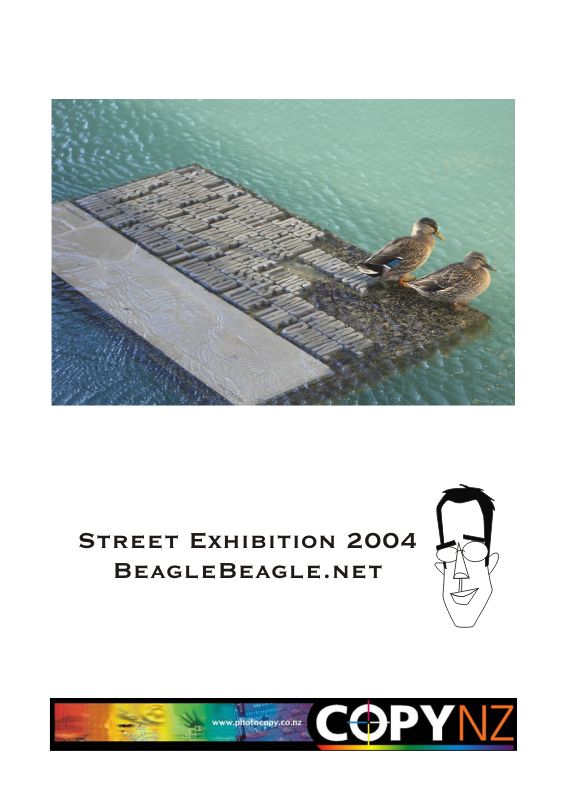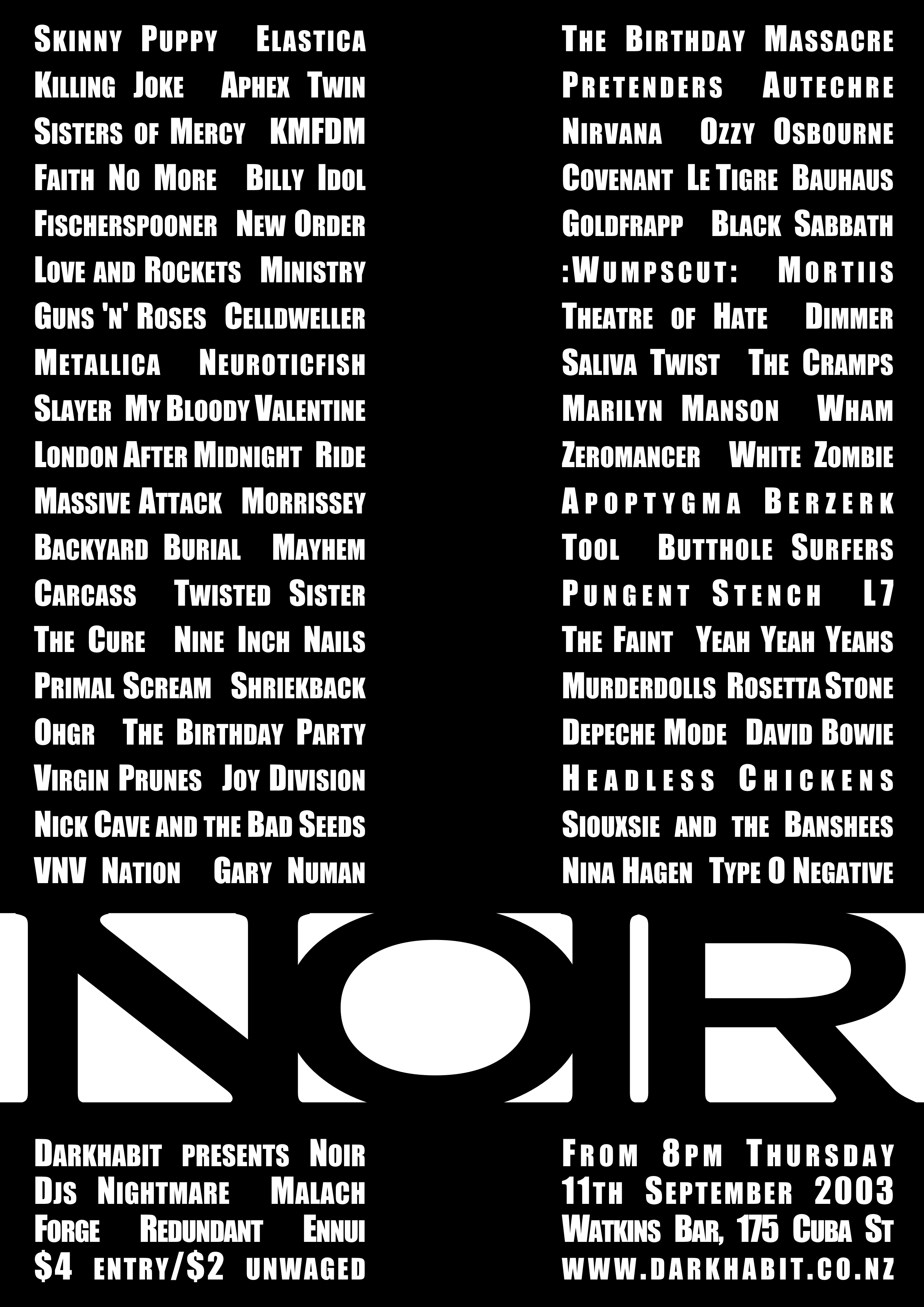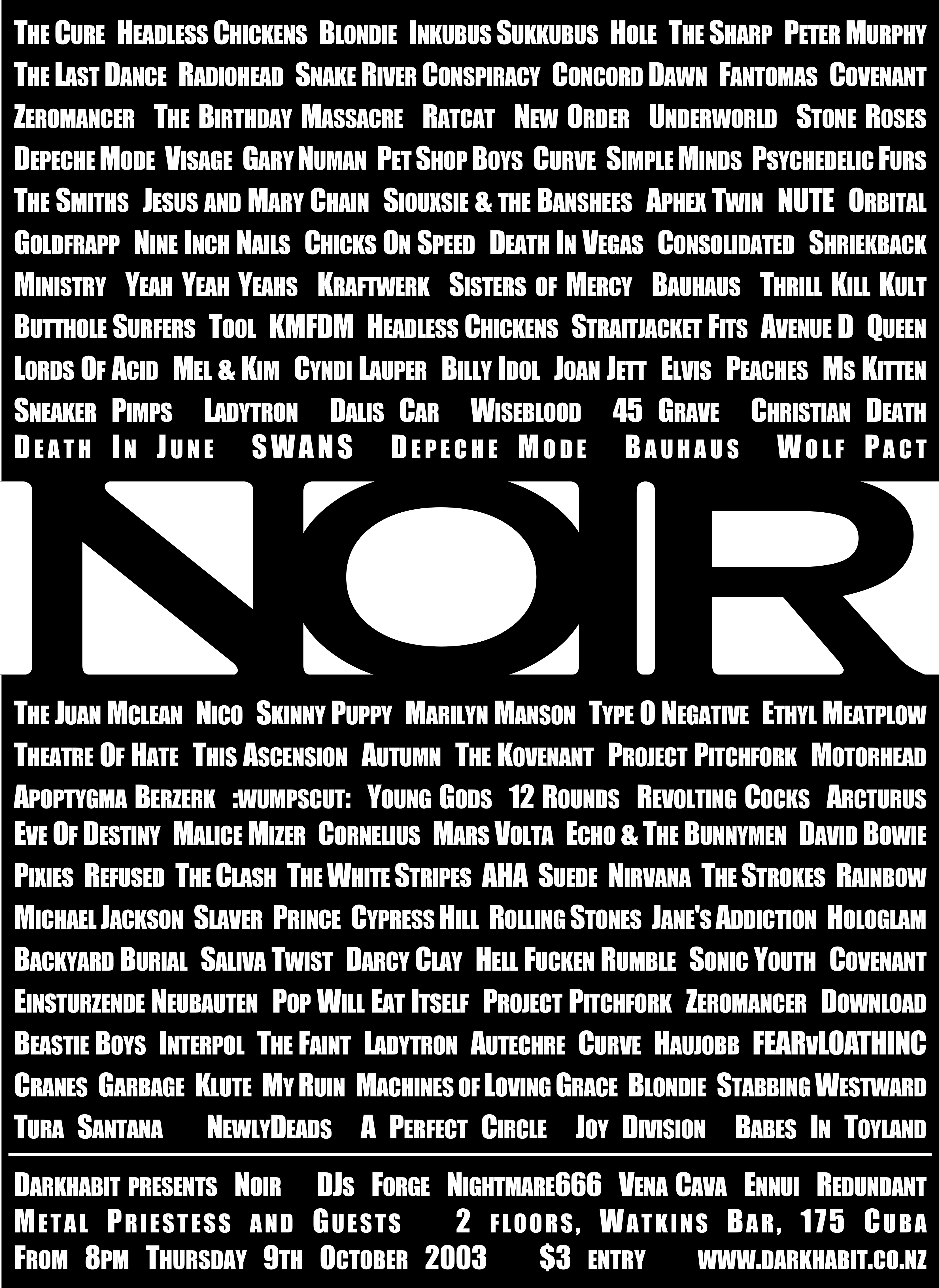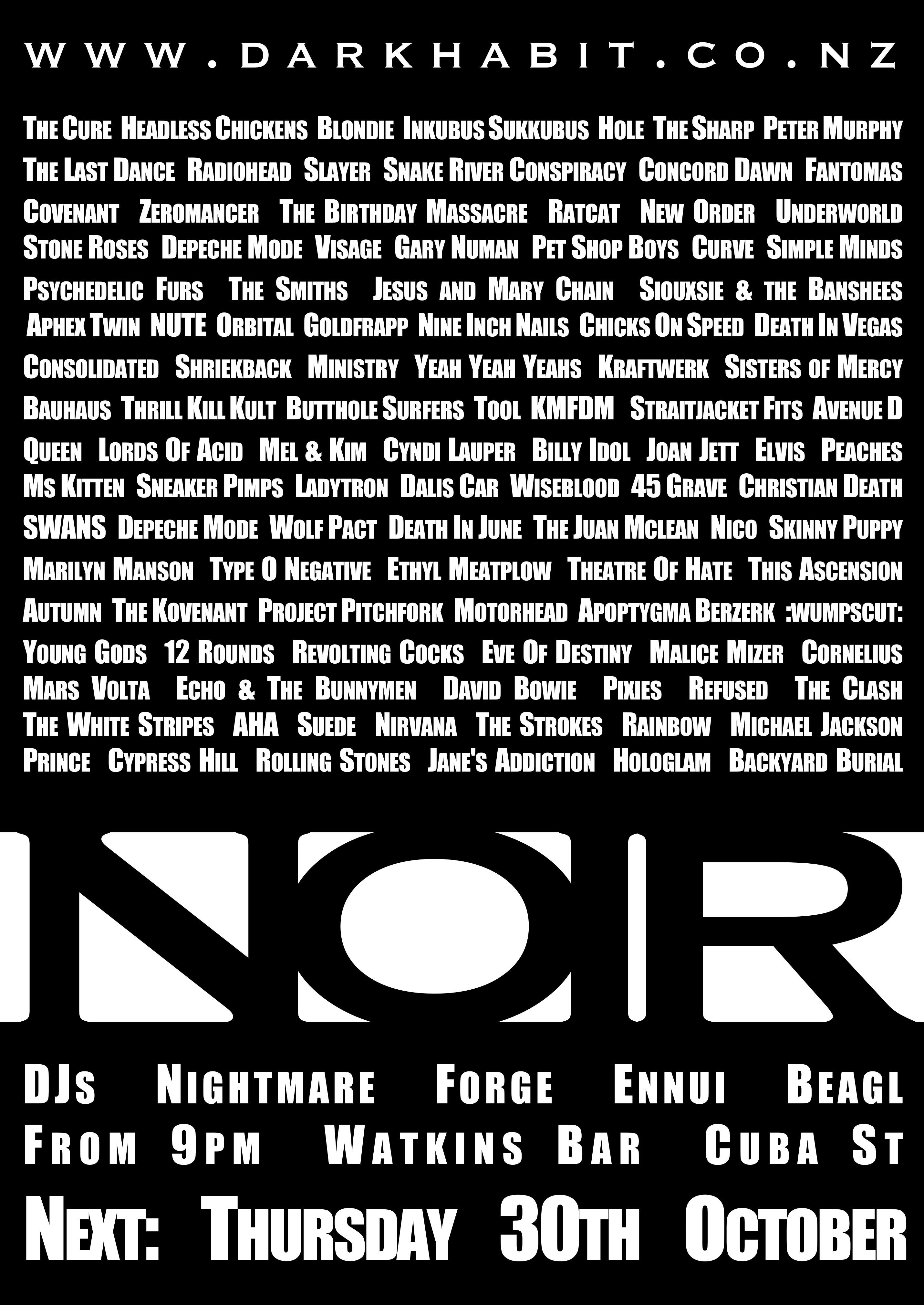I enjoyed getting into digital photography, starting with an Olympus camera that we bought in Las Vegas in 2000. It took photos at 1280×960 pixels and I got both an 8MB and a 16MB SD card for it.
Cameras came and went. There were was a superslim Casio Exilim EX-Z4, a Ricoh Caplio R4 with the big zoom, my beloved Canon 300D + 50mm prime, a Sony RX100, a Canon 650D that always disappointed. I took snaphots and sometimes I tried to take art, but there was always the issue of what to do with the photos once they’re taken. Sure I had a Flickr account but there had to be more.
So I came up with the idea of doing a public photo exhibition. But it wouldn’t just be open to the public in a room somewhere, rather I’d bring the exhibition to the people! I was already used to postering both officially and unofficially for music (Darkangel & Eros, Noir) gigs and political causes ([redacted]) so it was an obvious choice. My photos would be displayed on Wellington’s walls for all to see.
I chose the photos, organised sponsorship from a printing company towards the costs, and arranged for Sticky Fingers to post them up all over town. Here’s what they looked like in place:

And here’s all six of the posters:






A website with all 250 of my #NerdCryptic clues so far!
The website itself is a retro exercise in anti-style. Written in plain HTML with no UI frameworks or loading screens in sight, all colour and font decisions have been left for your browser to make.
It’s been 11 years since I last updated my home entertainment system (2007 original) and a lot has changed in that time. Speakers got smart, game consoles got better, streaming audio and video is normal, and we’ve got the better internet to support it all. So here’s the 2022 version.
Main features of the system
- Play any music anywhere in the house using networked Sonos speakers.
- Watch locally stored or streamed video anywhere in the house.
- Monitor the outside world on security cameras.
- Print or scan from anywhere.
- Play games on the Xbox One X.
- Centralised store of data both local and cloud.
System elements
No diagram this year because it’s all very obvious. The house has ethernet to every room so everything either goes back to the switch or connects over the wireless.
- A range of Sonos smart speakers strewn through the house and on the deck. They stream music from Tidal or Sonos Radio, or play from the music stored on the server. Stuck on the older Sonos S1 due to having a couple of old Play:5 speakers.
- Delicious the Dell 7810XL workstation being used as a server running Windows 10 and HyperV. Central file share plus Plex media server. All disks mirrored with 2 x 256GB SSD and 2 x 8TB SMR hard drives.
- Personal Windows 10 workstation running as a VM on the server.
- Unifi network with USG router, 24 port PoE switch, AC Pro AP and a Cloudkey 2+ to bring them all in the darkness and manage them.
- Unifi cameras monitoring the approaches of the house with footage stored locally on the Cloud Key 2+.
- Microsoft Xbox One X used for gaming and media playback on the family TV in the micro-cinema. Samsung 55″ TV with Samsung playbar and wireless subwoofer and surround speakers.
- Internet from Trustpower gigabit fiber to some ISP supplied hardware box.
- Family tools include Office 365, OneDrive, laptops, desktops, Android phones, Gmail for email, Discord for group chat, Signal as an SMS replacement.
Things we haven’t done yet
- No voice-control.
- Very little Internet of Things, apart from a few lightbulbs that can have their colour and brightness controlled from a phone.
Next
Everything is working very well.
We left Wellington in 2001 and spent a few months touring around the USA south-west before going and living on Vancouver Island for most of a year. Then it was off to Melbourne for a couple of years before returning to Wellington. We got involved with a few others and formed Darkhabit to put on some more gigs under the Noir name.
Here’s the posters I can find. My favourite was always the one from September 11th 2003, 2 years after the 9/11 terrorist in the USA. See if you can spot the tribute.





Darkangel & Eros was our initial foray into promoting goth gigs in Wellington. We started with a live gig called Pantomime featuring FearvLoathinc but the hand-created poster for that appears to be lost.
The real intention behind Darkangel & Eros was to organise DJ nights. I’d greatly enjoyed the ones I went to in Sydney and wanted something similar for Wellington.








Nuclear Risk Diplomacy is a fast-paced strategy game where threat and bluster are a key part of the gameplay. While played on the Diplomacy board with the same pieces, it’s quite a different game where the combat is more Risk like, and of course there’s also the nukes.
A single nuclear weapon lays waste to an entire region (and the forces in it) and can be played at any time. But do you use them as weapons to get ahead or keep them as a deterrent to stop people using theirs on you? Should you build nukes or armies? With nukes you can eliminate another player at will, but then you’ll have nothing to defend yourself with when the other players’ armies roll over your borders. It’s all about maintaining the balance of terror!
I have no idea where this game came from or who created it. I was taught it in the late 1980s by some friends. These are the rules as I remember them and you’ll need to know the Diplomacy rules to understand them. Please send any comments to thomas@thomasbeagle.net
Requirements
- Standard Diplomacy set.
- 15 two-sided counters to represent nuclear weapons (nukes). Coins are ideal.
Setup
Set up board according to the Diplomacy rules.
Use the Diplomacy rules to choose which countries are playing (according to the number of players) and then randomly assign them to the players.
Allocate two nukes to each player. These should be placed on the coloured country name tags on the edge of the board. The stockpile of unallocated nukes are placed on Iceland.
Method of Play
Turns in NRD are either spring or fall. The game starts with spring and then alternates between them. (You may wish to use an indicator so that people don’t get confused.)
Choose a player to start the first turn. The start then rotates clockwise around the players changing each turn.
Each player in turn then moves their units, resolving any attacks as they go. The player gets to decide the order in which they move their pieces. Each unit can only be used once per turn.
Building Units and Nukes
At the end of the fall turn players get to build/lose army/navy units to match the number of supply centres they control. They must control at least one of their home supply centres to be able to build.
Building/reducing units happens at the end of the fall turn, in exactly the same way as in Diplomacy – except that you can also build nukes. Building a nuke requires two supply centres. A player cannot build a nuke if there are none available.
Nukes that have already been added to a player’s arsenal do not need to be supported by supply centres.
Playing Units and Combat
Units (army/navy) can move to an adjacent region, support an attack by another unit or stay where they are. Convoying (armies being transported by one or more fleets) works the same as in Diplomacy. There is no supporting defense.
Battles result when one unit (possibly supported by others) tries to move into a region already occupied by an opposing unit. The attacking player and the defending player roll a D6 for each piece involved, with the highest roll being the winner (draws are resolved in favour of the defender).
If the attack fails, nothing happens. If the attack succeeds, the defending player’s unit must retreat to an adjacent unoccupied region chosen by the defender (not the one where the attacker came from). If there is no where to retreat to the unit is destroyed.
Support
A unit can support the attack of another unit if the supporting unit is in a position where it could also move into the attacked region. Each supporting unit gives the attacking play an additional D6 to roll. Note that dice rolls are not added – if the attacker attacks with two armies and rolls a 2 and a 4 while the defender rolls a 5, the defender wins.
Playing Nukes
Nukes are played by placing them on a region of the board. This can be done by any player at any time.
The region is then contaminated and is impassable.
Supply centres that have been nuked cannot be used to support units and cannot be built on.
Nukes cannot be played at half-strength.
Mutants
If a unit is in the region when it is nuked, there is a 1 in 6 chance that the unit will spawn mutants. The player that the unit belongs to rolls a D6 and mutants are spawned if a 6 is rolled. The player then removes the nuked unit and places three additional units of their choice in regions adjacent to the nuked region.
Mutants are then treated as normal units. If you nuke your own army and get mutants, you may then move them as normal in that turn.
Nuke Clean Up
Regions contaminated by nukes can be rehabilitated by moving two units into them (at the cost of the units). Moving one unit in kills the unit and sets the contamination to half-strength (flip the coin representing the nuke). Moving a second unit into the region kills the unit, removes the contamination, and the nuke is returned to the stockpile.
A cleaned up supply centre does not belong to any player. (Therefore, to clean up a supply centre and take it you must move two in to clean it up and then move another in to take it. This can all be done in the same turn.)
Elimination and winning
Players are eliminated after losing all of their armies/navies, nukes, and home supply centres. Note that a player who has no armies or supply centres, and therefore cannot win, can still stay in the game and use their remaining nuclear stockpile to exact revenge.
The game is over when one player has control over half of the supply centres (18 supply centres out of 34) at the end of the fall turn, or when all other players are eliminated.
Variations
Vary the number of nukes allocated to the players at the start.
Vary the number of nukes in the game.
In 2009 I posted an article about how much I was prepared to pay for books, music, movies, etc. 12 years later it must be well past time for an update. There’s been some big changes, in particular how my music/watching has all moved to subscription services and all my fiction reading is digital.
Currently I’m prepared to spend (all NZ dollars):
- Nothing for an ‘album’ worth of music. It’s either included with my Spotify subscription or I’m ignoring it in favour of something that is.
- Nothing on a fiction paper book as all my reading is electronic now. I have asked for and received a couple of lovely coffee table books as presents.
- Up to $10 on an electronic book even if it’s encumbered and locked to my reading device.
- Up to $40/year for access to a good website or online service (e.g. MyFitnessPal, Scrabble, LastPass).
- Up to $10 for a phone app or up to $5 if it’s pretty trivial.
- Up to $15 to see a movie in a cinema but I don’t bother anymore.
- I guess up to $5 to watch a movie online (but I haven’t really bothered, it’s easier to watch Netflix).
- I guess up to $2 for a downloaded TV episode (but really it’s Netflix/TVNZ On Demand or nothing).
- New entry: I don’t really buy video games any more as I get more than enough from my $20/month Gamepass subscription.
2025 Update
Not a lot has changed since 2021.
- Spotify is now Tidal
- I’ll spend up to $10 on an ebook (Kobo or Kindle) without thinking about it too much, and up to $20 for something I really want.
- Gamepass Ultimate is now $29/month, and I recently bought the game Split Fiction for $70!
These are our house rules for the card game 500. Some are designed to encourage higher bidding and thus a more interesting game, while others just clarify ambiguous rules.
- Players can re-enter bidding when it is their turn, even if they passed in an earlier bidding round.
- The player with the successful bid can change their bid to any higher bid before picking up the kitty, but this restarts the bidding which continues as normal until three players pass in a row.
- Closed misere is scored as 130 points and this bid can be beaten by any bid of 7 or higher.
- Open misere is scored as 230 points and this bid can be beaten by any bid of 8 or higher.
- In no-trumps you can lead the joker and nominate its suit without constraint (i.e. it doesn’t matter whether you have played that suit before).
- In no-trumps you never have to play the joker.
- In no-trumps you cannot play the joker on a trick if you have a card of that suit.
While I’m pretty sure no one cares, here’s a new list of my gripes with the iPhone. I did one of these in 2011 when I switched from the iPhone 3GS to the Samsung Galaxy S2 (still one of my favourite phones).
Since then I’ve been through a couple more Samsung Galaxies (S3 and S4) before switching camps and trying out a Microsoft Lumia 640 running Windows Mobile 8.1 followed by Windows 10.
I was very surprised by how much I liked using Windows Phone and in particular I thought the “launcher” (i.e. the home screen, app drawer and icons/widgets) was significantly better than the Android and iOS equivalents. I liked it so much that I was seriously considering buying the new flagship Lumia 950 but then I got a new job which came with a company supplied iPhone 6S+.
While the iPhone 6S+ wasn’t quite what I’d have chosen for myself, I was still pretty pleased to get the top of the line model of one of the best smartphones on the market and I was curious to see how the iPhone and iOS had developed in the last 5 years. What I didn’t expect was that it would be so damn annoying. In no particular order:
- Apps seem to freeze or crash more than I’m used to, particularly when they’re trying and failing to update their data (e.g. Twitter and Scrabble).
- The built-in keyboard still doesn’t support swiping. “Hey”, you say, “iOS supports third party keyboards now!”. Unfortunately it doesn’t support them very well, with some parts (like search) still using the built-in keyboard, and other applications seeming to randomly switch between them. Adding insult to injury, Microsoft has released their excellent Flow keyboard for iOS – but not in New Zealand. (Update: Google Gboard keyboard is pretty good.)
- The iPhone 6S+ has bad physical design. It’s far too slippery. The rounded edges make it hard to pick up from a flat surface. The buttons still have unpleasant sharp edges. The camera is off-centre which means that it jiggles when you try to use it on a desk. It’s the first phone I’ve ever felt obliged to get a case for to overcome the flaws in the physical design (I note that the Apple leather case is very nice and helps with a number of these gripes).
- Related to this is that it’s surprisingly heavy, both in absolute terms and when you compare it to other phones with similar sized screens from other vendors. Compare the iPhone 6S+ with a 5.5″ screen at 192g to the Lumia 950XL with a 5.7″ screen at 165g or the Samsung Galaxy S7 Edge with 5.5″ at 157g. I really notice the extra weight when reading in bed, and it makes me wish I’d got the iPhone 6S instead.
- I haven’t been impressed by the battery life which, in such a heavy phone, should be pretty awesome. I think it’s worse than my last couple of phones but that’s pretty subjective. Annoyingly you can’t carry a spare battery and just swap it in (a feature becoming less popular in Android and Windows phones too). There’s also still no wireless charging.
- At NZ$1599 for an iPhone 6S+ with 64GB, damn it’s expensive.
- The use of a proprietary Lightning connector for charging means that it uses a different connector from pretty well every other device we own that all use micro-USB (camera, tablet, UE Boom speaker, Kim’s phone, etc). It got even worse when Kim upgraded to a Nexus 5X with USB-C – suddenly we had three connectors to support. On the other hand, at least USB-C seems likely to be the standard of the future, the Lightning connector is always going to be an orphan for which the cables cost significantly more than the other options.
- As mentioned earlier, the camera is in the wrong location right up in one corner. Yes folks, it’s the return of the “finger in shot” screw-ups. How come the rest of the industry has worked out that cameras belong in the middle but Apple still seems unaware?
- The home-screen/launcher feels like it’s hardly developed since my iPhone 3GS. Yep, it’s still just a bunch of icons. There’s still no widgets or live tiles for quick display of relevant information. The design guidelines seem to encourage making icons look as like each other as possible. You can’t even arrange them spatially except between pages – gaps aren’t allowed and they always autofill the available space. As for multi-page folders, I have no idea what they were thinking with that one.
- The Settings app is big and sprawly and really needs a good rethink. I scrolled through five screen pages worth of top level setting items and it’s just too much.
- Apple – I don’t care whether you rip off the notifications and quick settings design from Microsoft or Google, just choose one and get copying. Special mention: it seems very odd that I can’t force-touch or long-press the bluetooth and wifi icons in the settings slide-up to get to the settings for those functions.
- I really miss the back button. Every app does it its own way and sometimes they have both “back to the calling app” and “back within this app” – naturally I always get the wrong one. Even worse some apps seem to have no back at all so once you’ve acitvated them from another, the only way to get back is to use the task switcher. I’m prepared to admit that the back button on Android and Windows Phone isn’t always perfect but I’d rather have an imperfect one than none at all.
- There’s even more use of popup hidden UI elements than since the last time I griped about it in 2010. E.g. in Safari you don’t get any controls unless you jiggle the page the right way. Many apps are implementing swiping left or right to reveal hidden UI elements, but they’re both hard to discover and inconsistent between apps.
- I assumed that with Apple having such a large market share and only one supported browser that everyone would ensure their mobile web pages worked in Safari. Apparently not.
- I wish I could work out the magic that would let the iPhone consistently reconnect to my phone headset whenever it’s in range.
- Bluetooth control options aren’t very flexible. You can’t tell the iPhone that you want to use a bluetooth UE Boom 2 speaker for music but not for phone calls or notification sounds.
- The Search often seems to freeze up for 5-15 seconds between entering search terms and the “Search the Web” button being displayed. It’s very odd.
- When the iPhone screen is off there’s no way to tell if there’s any messages or other important notifications waiting for you. There’s no notification light, nor a Windows Phone style low-power always-on Glance screen with time/date/notifications.
- I have tried more than once to use Siri and we just don’t understand each other. Come back Cortana!
- The screen rotation settings don’t seem quite right. Sometimes it triggers too easily, sometimes not easily enough. I miss the hack I had on one of my Android phones where I could enable screen rotation for some apps (e.g. video and photos) but not others.
- Internet connection sharing works well – but apparently it’s such a critically important function that Apple has to add a blinking bar at the top to constantly warn you that you have it enabled. Even worse, this bar doubles the height of the top bar so that some applications don’t quite display properly.
- The multi-tasking is pretty shocking. You can’t keep a network client connected (e.g. IRC), apps have to be left active to download data (e.g. offline maps and music), many apps are very slow at updating their notification badges, and apps don’t keep in sync with their notifications (i.e. the badge shows there is a message but when you go into the app it shows no new messages until it refreshes).
- You can’t replace standard apps with others if you prefer Google Maps to Apple Maps, or Chrome to Safari. Indeed, there’s a general feeling that Apple applications and services are first class citizens and Apple wants to make everyone else’s stuff just run that little bit worse.
(Yes, this article is just an attempt to get everyone to tell me ways to fix all my gripes and thereby improve my iPhone experience.)
My daughter is now three years old and she’s amazing. Naturally I now know everything there is to know about parenting so here’s my advice for new parents (particularly aimed at affluent middle-class fathers in NZ who have two cats).
The first three months are the hardest, followed by the next three months. The three months after that were also hard but then it started to get easier and more enjoyable. (Even if it was still a lot of work.) I’m writing this just after my daughter turned three – she’s still hard work but I adore her absolutely and we have quite a lot of fun together.
It doesn’t matter how you feel about becoming a father or whether you wanted the baby or not. Decide now to commit to doing the best job you can and being the best father you can be. Any of the alternatives aren’t going to be good for anyone.
You will never go back to your “normal life”. This is your normal life, embrace it.
Go to the ante-natal classes. Go to the breastfeeding course. Yes, both of you.
Forgive your partner already and ask for their forgiveness in turn. I see that relationships are built on loving reciprocity. You do something for your partner because you love them, they feel even more warmly to you and do things for you because they love you. It’s a beautiful spiral of loving caring – and the introduction of a young baby screws it up pretty badly. You’re both exhausted and have very little time to look after each other and little energy to give. But you’re both doing your best and there’ll be time in the future to reconnect. That said, give your partner what you can when you can.
Don’t worry if you don’t get an instant hit of love and adoration when your child is born. It was pretty amazing on a number of levels but for me the bonding process took time. That said – make sure you’re leaving yourself open to it. Don’t let the sleeplessness and hard work turn you resentful and closed.
Get stuck in – don’t let your uncertainty or doubt hold you back from doing everything that your child requires. We all had to change our first nappy or give our first bath. Don’t let anyone else disenfranchise you by doing someone on your behalf that you can do perfectly well yourself. Don’t be the father who doesn’t want to be left alone with his own child because he’s too scared to care for them.
Question what you think you know. You probably have all sorts of ideas on how kids should be raised based on what your parents did, what your friends do and that half-remembered show you saw on TV. Do your whole family a favour and do some reading about the best way to bring up a kid. In particular learn about what real normal child development looks like (bad news: “sleeping through the night” doesn’t happen as soon or as consistently as you’d like). This article does a reasonable job of summing up the views I came to about raising a happy and healthy child.
I said it was hard work, right? Get in there and do the housework and the shopping and the errand running and taking the baby out for a walk so its mum can get just a couple of hours sleep. No matter how hard you work it probably won’t be as tough as it is for the mum who’s staying up most of the night breast-feeding the baby to sleep.
Your baby won’t give a shit about whether it has a beautiful nursery.
Non-specialist doctors and pharmacists are generally pretty ignorant about pregnancy, infants and breast-feeding. Do your own research – but make sure it’s from reputable websites that are backed by the best and latest in medical science. Bookmark http://kellymom.com for great evidence-based information about the care and feeding of babies and their mothers.
Using a clip-on bed is a good compromise between using a cot and having the baby in bed with you. This is where you have a separate sleeping surface for the baby attached to your bed so that you can both care for the baby in the night without having to get up. Our daughter went from the clip-on bed straight to her own bed without any problems at about 14 months. Her bed is a double mattress on a base and it’s been absolutely brilliant. It means that either of us can sleep with her on her bed if we ever need to (it also fits the two cats as well).
Get a tablet computer with good battery life for those long nights where that damn baby just won’t sleep unless it’s on someone. Block access to Trade Me if your budget won’t allow it.
Don’t let your duties (paid work, housework, maintenance, etc) take away from your time spent at home looking after your child and supporting your partner. It can be tempting to avoid the stress at home by saying “Oh, I need to do this” but your #1 priority at this time should be your family.
You need a lot less stuff than the glossy brochures would tell you that you need. And do you really need a baby buggy at all? We never really used them, preferring front-packs and back-packs and good old fashioned carrying.
Parent the child you have. Keep an eye on the expected milestones but ultimately you have to care for your child as it is, not the ideal child you have in your head, not your friend’s child, and not what some book has told you to expect.
Parenting is hard work but the first time you get a big cuddle and an “I love you Daddy” from your child – oh. my. god.
